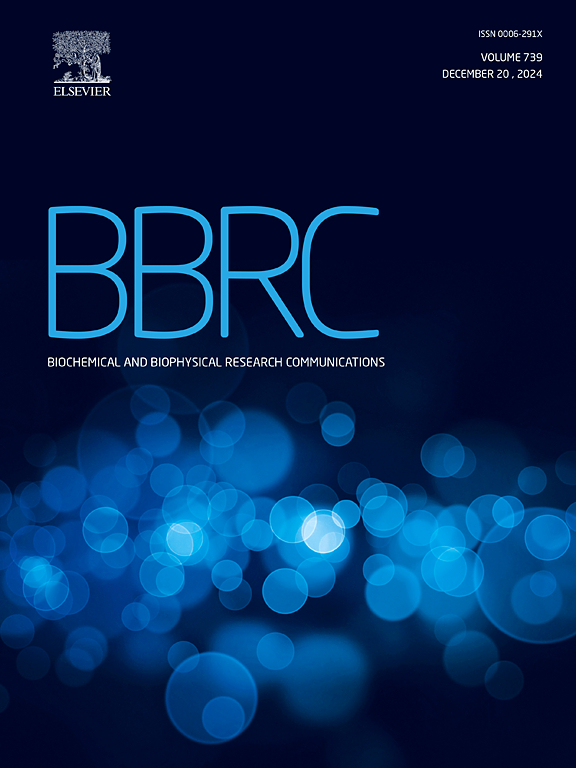Mating modifies oxidative stress in the brain and confers protection against Parkinson's Disease in a Drosophila model
IF 2.2
3区 生物学
Q3 BIOCHEMISTRY & MOLECULAR BIOLOGY
Biochemical and biophysical research communications
Pub Date : 2024-10-28
DOI:10.1016/j.bbrc.2024.150911
引用次数: 0
Abstract
Mating exerts profound and multifaceted effects on the physiology of female insects, particularly influencing metabolic alterations and bolstering stress resilience. Drosophila melanogaster has emerged as an excellent model to investigate the mechanism of neurodegenerative diseases. However, interplay between mating and its impact on the Drosophila brain remains a tantalizing enigma, awaiting elucidation. Herein, we reported that mating significantly improved the climbing and jumping activity in mated females compared to the virgins in Drosophila. Mating also reduced oxidative stress in the brain. Based on the results, we found that, mated females exhibited better behavioral performance and fewer loss of dopaminergic (DA) neurons than unmated females in PINK1 RNAi flies, a well-established Parkinson's disease (PD) model. Further study demonstrated that mating led to decreased iron content in the brain, a process associated with decreased Transferrin 1 (Tsf1) and Malvolio (Mvl) and increased ferritin. Additionally, mating inhibited expression of Duox and Nox, two NADPH oxidases in Drosophila. Furthermore, Kr-h1, a transcription factor of JH, acted downstream of mating to regulate genes involved in iron metabolism and NADPH oxidases. Collectively, the findings suggested a pivotal role of mating in regulating iron metabolism and NADPH oxidases in the brain of Drosophila. Consequently, considering mating status is imperative in scientific research, particularly in the context of neurological disorders.
在果蝇模型中,交配可改变大脑中的氧化应激并使其免受帕金森病的侵袭
交配对雌性昆虫的生理产生深远和多方面的影响,尤其是影响新陈代谢的改变和增强应激恢复能力。黑腹果蝇已成为研究神经退行性疾病机理的绝佳模型。然而,交配及其对果蝇大脑的影响之间的相互作用仍然是一个诱人的谜团,有待阐明。在本文中,我们发现与处女果蝇相比,交配能显著改善交配雌果蝇的攀爬和跳跃活动。交配还降低了大脑中的氧化应激。基于这些结果,我们发现,在PINK1 RNAi果蝇(一种成熟的帕金森病(PD)模型)中,与未交配的雌果蝇相比,交配雌果蝇表现出更好的行为表现和更少的多巴胺能(DA)神经元丢失。进一步的研究表明,交配会导致大脑中铁含量的减少,这一过程与转铁蛋白1(Tsf1)和马尔瓦里奥(Mvl)的减少以及铁蛋白的增加有关。此外,交配抑制了果蝇体内两种 NADPH 氧化酶 Duox 和 Nox 的表达。此外,JH的转录因子Kr-h1在交配的下游发挥作用,调节涉及铁代谢和NADPH氧化酶的基因。总之,这些研究结果表明,交配在调节果蝇大脑中的铁代谢和NADPH氧化酶方面起着关键作用。因此,在科学研究中,尤其是在神经系统疾病的研究中,考虑交配状况是非常必要的。
本文章由计算机程序翻译,如有差异,请以英文原文为准。
求助全文
约1分钟内获得全文
求助全文
来源期刊
CiteScore
6.10
自引率
0.00%
发文量
1400
审稿时长
14 days
期刊介绍:
Biochemical and Biophysical Research Communications is the premier international journal devoted to the very rapid dissemination of timely and significant experimental results in diverse fields of biological research. The development of the "Breakthroughs and Views" section brings the minireview format to the journal, and issues often contain collections of special interest manuscripts. BBRC is published weekly (52 issues/year).Research Areas now include: Biochemistry; biophysics; cell biology; developmental biology; immunology
; molecular biology; neurobiology; plant biology and proteomics

 求助内容:
求助内容: 应助结果提醒方式:
应助结果提醒方式:


